How the Air BagsWork
How the Front Air BagsWork
When air bag crash sensors detect a frontal impact of greater than moderate
force, an
electrical current is sent to the inflators.
Gases are produced to inflate the front air bags and after the inflation, the
front air bags
quickly deflate.
The front air bags will function only once. After that, the front air bags
will not work
again and must be replaced.
Only an Authorized Mazda Dealer can replace the system components.
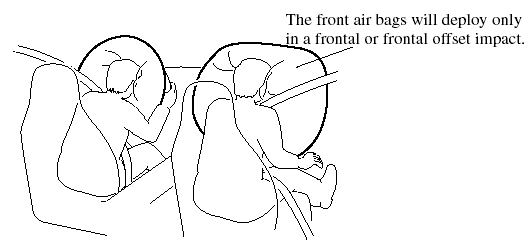
The front, dual stage air bags control air bag inflation in two energy
stages. During an
impact of moderate severity the front air bags deploy with lesser energy,
whereas during
more severe impacts, they deploy with more energy. Deployment of the front air
bags may
differ between the driver and the front passenger depending on the driver seat
position,
front passenger weight and front seat belt usage, all of which provide data from
each sensor
to the air bag system.
Driver seat slide position sensor
Your vehicle is equipped with a driver seat slide position sensor as a part
of the
supplemental restraint system. The sensor is located under the driver seat. The
sensor
determines whether the driver seat is fore or aft of a reference position and
sends the seat
position to the diagnostic module (SAS unit). The SAS unit is also designed to
control the
deployment of the driver air bag depending on how close the driver seat is to
the steering
wheel.
The air bag/front seat belt pretensioner system warning light flashes if the
sensor has a
possible malfunction.
Front passenger seat weight sensors
Your vehicle is equipped with a front passenger seat weight sensors as a part
of the
supplemental restraint system. These sensors are located under both
of the
front passenger seat rails. These sensors determine the total seated weight on
the front
passenger seat. The SAS unit is designed to prevent the front passenger front
and side air
bags and seat belt pretensioner system from deploying if the total seated weight
is less than
approximately 30 kg (66 lbs).
To reduce the chance of injuries caused by deployment of the front passenger air
bag, the
system deactivates the front passenger front and side air bags and also the seat
belt
pretensioner system when:
- There is no passenger in the front passenger seat. (The front passenger air
bag
deactivation indicator light does not illuminate.).
- The total seated weight on the front passenger seat is less than approximately
30 kg (66
lbs). (The front passenger air bag deactivation indicator light illuminates.).
This system shuts off the front passenger front and side air bags and seat
belt pretensioner
system, so make sure the front passenger air bag deactivation indicator light
illuminates
according to the following table.
The air bag/front seat belt pretensioner system warning light flashes and the
front
passenger air bag deactivation indicator light illuminates if the sensors have a
possible
malfunction. If this happens, the front passenger front and side air bags and
seat belt
pretensioner system will not deploy.
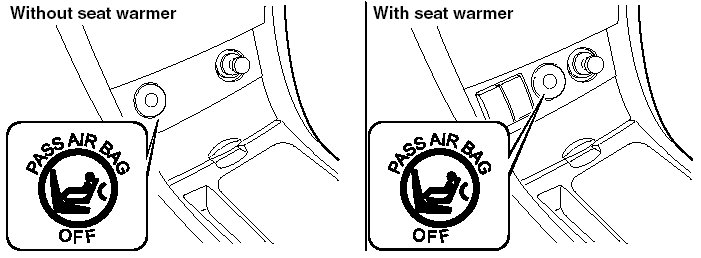
Front passenger air bag deactivation indicator light
This indicator light illuminates to remind you that the front passenger front
and side air
bags and seat belt pretensioner will not deploy during a collision.
If the front passenger weight sensors are working properly, the indicator
light illuminates
when the ignition switch is turned to the ON position. After a specified period
of time it
goes out.
The front passenger air bag deactivation indicator light illuminates or is off under the following conditions:

* If the front passenger seat belt is buckled, the front passenger air bag deactivation indicator light illuminates, however this does not indicate a malfunction.
Curtain air bag is always ready to inflate and is not deactivated like the passenger front and side air bag.
If the front passenger air bag deactivation indicator light does not
illuminate when the
ignition switch is turned to the ON position and does not illuminate as
indicated in the
above chart, do not allow a child to sit in the front passenger seat; contact
the Authorized
Mazda Dealer as soon as possible. The system may not work properly in an
accident.
WARNING:
Do not decrease the total seated weight on the front passenger seat:
When an adult or large child sits on the front passenger seat, decreasing the
total
seated weight on the front passenger seat from the total seated weight of
approximately 42 kg (93 lbs) required for air bag deployment is dangerous. The
front
passenger seat weight sensors will detect the reduced total seated weight
condition
and the front passenger front and side air bags and seat belt pretensioner
system
will not deploy during an accident. The front passenger will not have the
supplementary protection of the air bag, which could result in serious injury.
Decreasing the total seated weight on the front passenger seat from the total
seated
weight of approximately 42 kg (93 lbs) could result in an air bag not deploying
under
the following conditions, for example:
 A rear passenger pushes up on the front passenger seat with their feet.
A rear passenger pushes up on the front passenger seat with their feet.
 Luggage or other items placed under the front passenger seat or between the
Luggage or other items placed under the front passenger seat or between the
front passenger seat and driver seat that push up the front passenger seat
bottom.
 The front passenger seat occupant sits in a manner that does not place the
The front passenger seat occupant sits in a manner that does not place the
entire
weight of the occupant on the seat such as by sitting too close to the door,
grasping the assist grip or the rim of the moonroof and sitting with the
seatback
reclined too far.
 Any accessories which might decrease the total seated weight on the front
Any accessories which might decrease the total seated weight on the front
passenger seat are attached to the front passenger seat.
The front passenger front and side air bags and seat belt pretensioner systems
will
deactivate if the total seated weight on the front passenger seat is close to 30
kg (66
lbs) and they will reactivate before the weight exceeds 42 kg (93 lbs).
Do not increase the total seated weight on the front passenger seat:
When an infant or small child sits on the front passenger seat, increasing the
total
seated weight on the front passenger seat from the total seated weight of
approximately 30 kg (66 lbs) is dangerous. The front passenger seat weight
sensors
will detect the increased total seated weight, which could result in the
unexpected
deployment of the front passenger front and side air bags and seat belt
pretensioner
system in an accident and may cause serious injury. Increasing the total seated
weight on the front passenger seat beyond the total seated weight of
approximately
30 kg (66 lbs) could result in the front passenger front and side air bags and
seat
belt pretensioner system deployment in an accident under the following
conditions,
for example:
 Luggage or other items are placed on the seat with the child in the
Luggage or other items are placed on the seat with the child in the
child-restraint
system.
 A rear passenger or luggage push or pull down on the front passenger seatback.
A rear passenger or luggage push or pull down on the front passenger seatback.
 A rear passenger steps on the front passenger seat rails with their feet.
A rear passenger steps on the front passenger seat rails with their feet.
 Luggage or other items are placed on the seatback or hung on the head
Luggage or other items are placed on the seatback or hung on the head
restraint.
 The seat is washed.
The seat is washed.
 Liquids are spilled on the seat.
Liquids are spilled on the seat.
 The front passenger seat is moved backward, pushing into luggage or other
The front passenger seat is moved backward, pushing into luggage or other
items
placed behind it.
 The front passenger seatback contacts the rear seat.
The front passenger seatback contacts the rear seat.
 Luggage or other items are placed between the front passenger seat and driver
Luggage or other items are placed between the front passenger seat and driver
seat.
 Any accessories which might increase the total seated weight on the front
Any accessories which might increase the total seated weight on the front
passenger seat are attached to the front passenger seat.
The front passenger front and side air bags and seat belt pretensioner systems
will
deactivate if the total seated weight on the front passenger seat is less than
approximately 30 kg (66 lbs) and they will reactivate when the weight exceeds
approximately 42 kg (93 lbs).
CAUTION:
 To assure proper deployment of the front air bag and to prevent damage to the
To assure proper deployment of the front air bag and to prevent damage to the
sensors in the front seat bottoms:
 Do not place sharp objects on the front seat bottoms or
Do not place sharp objects on the front seat bottoms or
leave heavy luggage
them.
 Do not spill any liquids on the front seats or under the
Do not spill any liquids on the front seats or under the
front seats.
 To allow the sensors to function properly, always perform the following:
To allow the sensors to function properly, always perform the following:
 Adjust the front seats as far back as possible and always
Adjust the front seats as far back as possible and always
sit upright against the
seatbacks with seat belts worn properly.
 If you place your child on the front passenger seat, secure
If you place your child on the front passenger seat, secure
the child-restraint
system properly and slide the front passenger seat as far back as possible.
NOTE:
- The system requires about 10 seconds to alternate between turning the front
passenger front and
side air bags and seat belt pretensioner system on or off.
- The front passenger air bag deactivation indicator light may illuminate
repeatedly if luggage or
other items are put on the front passenger seat, or if the temperature of the
vehicle's interior
changes suddenly.
- The front passenger air bag deactivation indicator light may illuminate for 10
seconds if the total
seated weight on the front passenger seat changes.
- If the front passenger air bag deactivation indicator light does not
illuminate after installing a
child-restraint system on the front passenger seat, install the child-restraint
system on the rear
seat and consult an Authorized Mazda Dealer as soon as possible.
Driver and front passenger buckle switches
The buckle switches on the front seat belts detect whether or not the front
seat belts are
securely fastened and further control the deployment of the air bags.
How the Side and Curtain Air Bags Work *
* Some models.
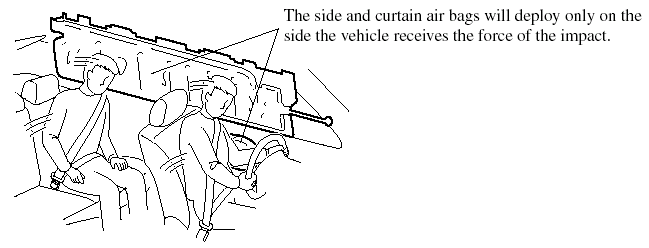
When air bag crash sensors detect a side impact of greater than moderate
force, an
electrical current is sent to the inflators.
Gases are produced to inflate the side and curtain air bags and after the
inflation, the side
and curtain air bags quickly deflate. However, the side air bag system for the
front
passenger is designed to only deploy in accordance with the total seated weight
on the front
passenger seat, however the curtains are not deactivated.
The side and curtain air bags will function only once. After that, the side
and curtain air
bags will not work again and must be replaced.
Only an Authorized Mazda
Dealer can
replace the systems.
Air Bag Activation/Deactivation
NOTE:
If the front passenger seat weight sensors detect a total seated weight on the
front passenger seat is
less than approximately 42 kg (93 lb), the front passenger front and side air
bags and seat belt
pretensioner may not deploy, but the curtain air bags may deploy.
Front air bag activation
The front air bags will inflate if the severity of impact is above the designed threshold level.
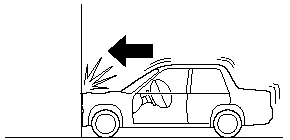
- Hitting a solid wall straight on at greater than about 22 km/h (14 mph).
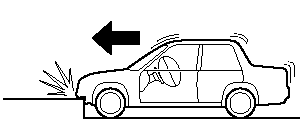
- Hitting a curb, pavement edge or hard object.
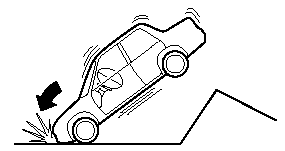
- Landing hard or the vehicle falling.
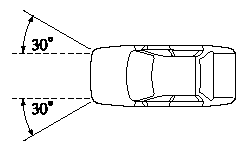
- Frontal impact within about a 30 degree range from head-on to the vehicle.
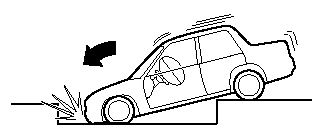
- Driving into a big hole or hitting the far side of a hole.
Limitations to front air bag activation
Depending on the severity of impact, the front air bags may not inflate in the following cases:
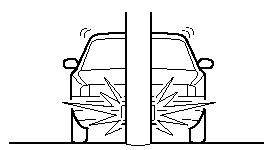
- Impacts involving trees or poles cause severe cosmetic damage but may not have enough stopping force to activate the air bag.
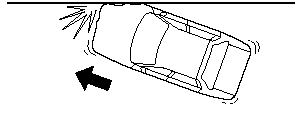
- Frontal offset impact to the vehicle may not provide the stopping force necessary for air bag deployment.
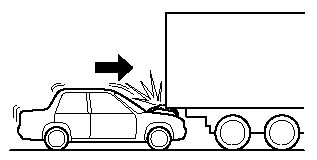
- Rear-ending or running under a truck's tail gate may not provide the stopping force necessary for air bag deployment.
Non-activation of front air bags
Front air bags will not normally inflate in the following cases:
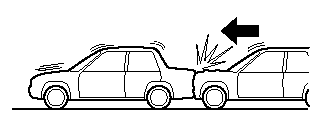
- Collision from the rear.
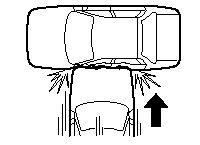
- Impact to the side, but it may deploy the side and curtain air bags.

- Vehicle roll-over, may deploy the side and curtain air bags but not the front air bags.
Side and curtain air bag activation *
* Some models.
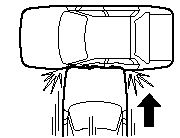
The severity of impact above the designed threshold level to one side of the vehicle (driver or passenger side areas) will cause the side and curtain air bags on that side to inflate, but it will not normally deploy the front air bags.
Limitations to side and curtain air bag activation *
* Some models.
Depending on the severity of impact, the side and curtain air bags may not inflate in the following cases:
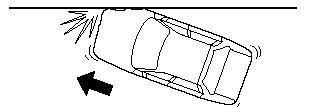
- Frontal offset impact may not provide enough side impact to deploy the side and curtain air bags.
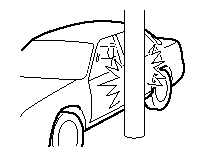
- Side impacts involving trees or poles can cause severe cosmetic damage but may not have enough impact force to activate the side and curtain air bags.
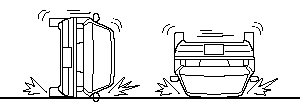
- Vehicle roll-over may not provide enough side force to deploy the side and curtain air bags.

- Side impacts with two-wheeled vehicles may not provide enough force to deploy the side and curtain air bags.
Non-activation of side and curtain air bag *
* Some models.
The side and curtain air bags will not normally inflate in the following cases:

- Collision from the rear.
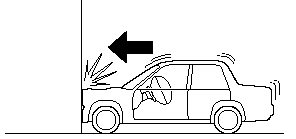
- Collision from the front, but it may deploy the front air bags.
Constant Monitoring
The following components of the air bag
systems are monitored by a diagnostic
system:
- SAS unit.
- Front air bag sensor.
- Air bag modules.
- Side crash sensors *.
- Air bag/Front seat belt pretensioner system warning light.
- Front seat belt pretensioners.
- Front passenger air bag deactivation indicator light.
- Related wiring.
- Driver seat slide position sensor.
- Front passenger seat weight sensors.
- Driver and front passenger seat belt buckle switches.
* Some models.
The diagnostic module continuously monitors the system's readiness. This begins when the ignition switch is turned to the ON position and continues while the vehicle is being driven.
Air Bag/Front Seat Belt Pretensioner System Warning Light

If the air bag/front seat belt pretensioner system is working properly, the warning light illuminates when the ignition switch is turned to the ON position or after the engine is cranked. The warning light turns off after a specified period of time.
A system malfunction is indicated if the warning light constantly illuminates or does not illuminate at all when the ignition switch is turned to the ON position. If any of these occur, consult an Authorized Mazda Dealer as soon as possible. The system may not work in an accident.
WARNING:
Never tamper with the air bag/
pretensioner systems and always have
an Authorized Mazda Dealer perform
all servicing and repairs:
Self-servicing or tampering with the
systems is dangerous. An air bag/
pretensioner could accidentally
activate or become disabled causing
serious injury or death.
Air Bag/Front Seat Belt Pretensioner System Warning Beep
If a malfunction is detected in the air bag/ front seat belt pretensioner systems and the warning light, a warning beep sound will be heard for about 5 seconds every minute.
The air bag and seat belt pretensioner system warning beep sound will continue to be heard for approximately 35 minutes.
Have your vehicle inspected at an Authorized Mazda Dealer as soon as possible.
WARNING:
Do not drive the vehicle with the air
bag/front seat belt pretensioner system
warning beep sounding:
Driving the vehicle with the air bag/
front seat belt pretensioner system
warning beep sounding is dangerous.
In a collision, the air bags and the front seat belt pretensioner system will not deploy and this could result in death or serious injury.
Contact an Authorized Mazda Dealer to have the vehicle inspected as soon as possible.
Maintenance
The air bag systems do not require regular maintenance. But if any of the following occurs, take your vehicle to an Authorized Mazda Dealer as soon as possible: - The air bag system warning light flashes.
- The air bag system warning light remains illuminated.
- The air bag system warning light does not illuminate when the ignition switch is turned to the ON position.
- The air bag system warning beep sound will be heard.
- The air bags have deployed.
- Front passenger air bag deactivation indicator light does not illuminate when the ignition switch is turned to the ON position or does not illuminate as indicated in the chart. For more details about this indicator light and this chart, refer to “Front passenger seat weight sensors”.
WARNING:
Do not operate a vehicle with damaged
air bag/seat belt pretensioner system
components:
Expended or damaged air bag/seat
belt pretensioner system components
must be replaced after any collision
which caused them to deploy or
damage them. Only a trained
Authorized Mazda Dealer can fully
evaluate these systems to see that
they will work in any subsequent
accident. Driving with an expended
or damaged air bag or pretensioner
unit will not afford you the necessary
protection in the event of any
subsequent accident which could
result in serious injury or death.
Do not remove interior air bag parts: Removing any components such as the front seats, front dashboard, the steering wheel or parts on the front and rear window pillars and along the roof edge, containing air bag parts or sensors is dangerous. These parts contain essential air bag components. The air bag could accidentally activate and cause serious injuries. Always have an Authorized Mazda Dealer remove these parts.
Dispose of the air bag properly: Improper disposal of an air bag or a vehicle with live air bags in it can be extremely dangerous. Unless all safety procedures are followed, injury can result. Ask an Authorized Mazda Dealer how to safely dispose of an air bag or how to scrap an air bag equipped vehicle.
NOTE:
If it becomes necessary to have the components
or wiring system for the supplementary
restraint system modified to accommodate a
person with certain medical conditions in
accordance with a certified physician, contact
an Authorized Mazda Dealer, refer to
“Customer Assistance (U.S.A.)”.
See also:
Brake Fluid
Inspecting Brake Fluid Level
Inspect the fluid level in the reservoir
regularly. It should be kept at MAX.
The level normally drops with
accumulated distance, a condition
associated with wear o ...
How the Air BagsWork
How the Front Air BagsWork
When air bag crash sensors detect a frontal impact of greater than moderate
force, an
electrical current is sent to the inflators.
Gases are produced to inflate the fro ...
Starting a Flooded Engine
If the engine fails to start, it may be
flooded (excessive fuel in the engine).
Follow this procedure:
1. If the engine does not start within five
seconds on the first try, turn the key to
the LO ...


